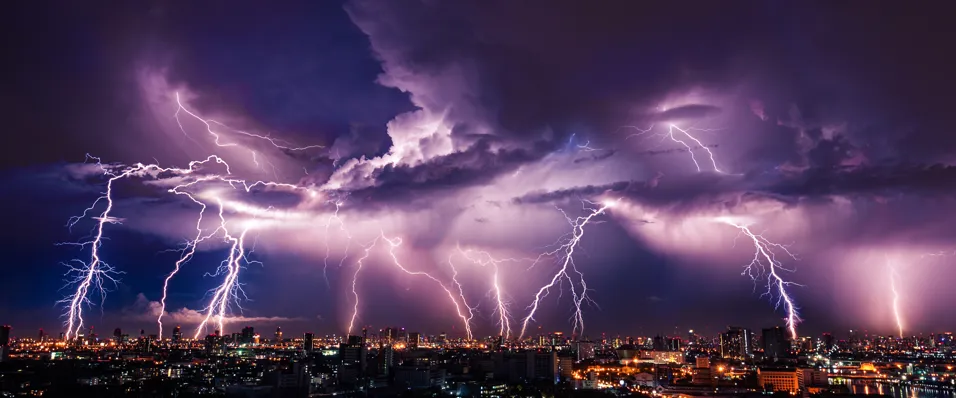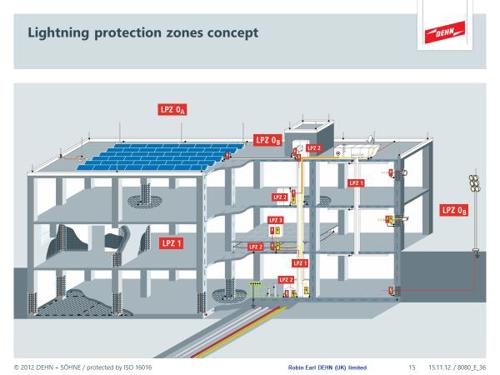
Impact of the changes in the 18th Edition IET Wiring Regulations on the Lightning Protection and Surge Protection Industry
Structural lightning protection has been with us since the late 19th century in one form or another, but it was only really formalised into a coherent standard with the release of BS 6651 in 1985. The adoption of the IEC standard in 2006 gave the UK the current BS EN 62305 which also contained the first real attempt to include comprehensive co-ordinated surge protection. The awareness of surge protection, its uses and benefits have been something of a ‘slow burn’ in the UK and even 12 years on from the release of BS EN 62305 surge protection can often be seen as something of a ‘dark art’.
One of the key changes in the 18th Edition will be the requirement for surge protection devices (SPDs). This is a real seed change in the industry in the UK with the emphasis moving from a point of view of ’are they really required?’” to the new view which is very much ’prove you don’t need them!’.
The 17th Edition contained a fairly lengthy and somewhat complicated risk assessment process including “AQ criteria” and “ceraunic levels” to establish whether SPDs were required or not. This is no longer included in the 18th Edition. Instead in Section 443 we have some very definitive criteria, which, if appropriate and applicable to your project, completely removes the requirement to carry out a risk assessment.
This section now states:
“Protection against transient over voltages shall be provided where the consequence caused by overvoltage effects:
(a) results in serious injury to, or loss of, human life, or
(b) results in interruption of public services and/or damage to cultural heritage,
(c) results in interruption of commercial or industrial activity, or
(d) affects a large number of collocated individuals”.
That covers an awful lot of structures in the UK without having to resort to a risk assessment. It is also heavily on the side of installing SPDs in the majority of cases. In addition to this, any structure fed via an overhead supply line shall also require an SPD.
Structures not covered by these stringent categories still require a risk assessment to be carried out. Here, the process has been simplified but there is still a fair amount of data that needs to be collected prior to undertaking the assessment. The new amendment offers a route around this process by stating that if the risk assessment is not carried out then SPDs shall be fitted in all cases. It’s not envisaged that this risk assessment will be completed by the lightning protection specialist, this is likely to be carried out along with other calculations relating to the LV distribution system.
This may not mean a great deal of change for many of the existing ATLAS accredited designers who were already well aware of the requirements for SPDs and the process of determining their use. However, a major change to Section 534 is a raft of measures that spell out the actual deployment of surge protection measures and here the real economic impact is felt. This roll out of SPDs is achieved by following the lightning protection zone concept (LPZ) – a concept directly taken from the current lightning protection standards BS EN 62305: 2012.
Regulation 534.4.1.1 requires SPDs to be installed at the origin of the installation and then further SPDs deeper within the low voltage (LV) distribution or data system to protect from surges generated from induced voltages or frequency oscillations within. Simply put; an SPD is required whenever a cable enters or leaves the internal zone (zone 1) from the external zone (zones 0a or 0b). There is also a requirement for additional SPDs to be installed each time a cable or service crosses an internal zonal boundary. These internal zones are to be determined via consultation with the end client and their associated specialist advisors/contractor.
Which type of SPD is installed at the origin, depends on whether there is a structural lightning protection system (LPS) installed or not. Type 1 SPDs should be installed if there is a fitted LPS and type 2 if there is no fitted LPS. Then the exact position of the service line/cable must be looked at, if there is a fitted LPS. A type 1 device is definitely required if any cable or service line is routed from the outside the zone of protection afforded by the structural LPS (external zone 0a) this would also include any plant or services which have been ‘bonded’ into the structural lightning protection system. If the external load is within LPZ0b (an area protected by a structural LPS with air rods or catenary wire system for example) then no direct strike is possible so a type 2 device is acceptable.

Figure 1: Lightning protection zones concept
Just how well the zonal concept will work in practice remains to be seen; this concept has existed within the lightning protection standards for 12 years but remains widely misunderstood outside of that specialist, niche industry. The requirement for zoning a structure really does need some in-depth input and thought on behalf of the end client and their specialist contractor, exactly which services and equipment will be critical for the function of their structure and their ongoing business continuity will have to be determined at as early a stage as possible. This conversation will be one that some lightning protection installers have not had previously, it will now become unavoidable.
All the above must be addressed at the design stage, the initial risk assessment, the location of the LPZ zones and the level of LPS required (if any) must be known from the onset so the SPDs can be factored in for the panel builder to allow space in the control or power panels.
The LPZ zones are fundamentally derived from any structural lightning protection requirements and these are driven by the risk assessment process within BS EN 62305. This information will now be required at a very early stage in the planning and design phase.
Additional care will need to be taken with any structures which are covered by The Dangerous Substances and Explosive Atmospheres Regulations 2002 (DSEAR) or The Control of Major Accident Hazards Regulations 2015 (COMAH). Lightning and LV overvoltage faults are dangerous sources of ignition in hazardous areas that need to be controlled to prevent explosion, the SPD requirement on such projects will therefore become even more important and the zonal concept even more stringent, as an industry we are going to have to become better informed.
These new regulations will mean that there will have to be a far closer commercial, technical and engineering relationship between the end client, the M&E designer/contractor, the panel manufacturer and the lightning protection specialist. Previously this relationship has been quite limited. It is impossible to imagine that all the requirements of Sections 443 and 534 could be fully understood and met without these parties enjoying a closer and more mutually beneficial relationship going forward. It is a relationship that may have to be driven by the lightning protection specialist.
Clearly there are huge opportunities ahead for the whole industry as the volume of SPDs required will increase dramatically. In addition to this, the consultation required with lightning protection contractors will now include projects where there is no structural LPS, typically projects the industry had no prior input or knowledge of. However, potential commercial benefits need to be countered by ensuring that the end client receives the correct technical solution but this is certainly a large growth area.
Training and continuing personal development (CPD) will be essential to ensure that the knowledge base is extended right through the project delivery chain from estimator, to contract manager and site supervisor if the full remit of BS 7671 and BS EN 62305 are to be realised and a project safely and correctly signed off as compliant. Training courses are already being planned which will be delivered through ATLAS (Association of Technical Lightning & Access Specialists).
